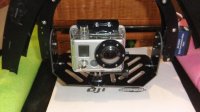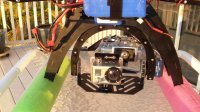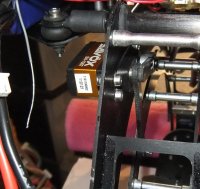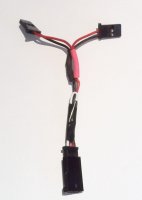GGoodrum
Member
I've been continuing to do some tweaks in order to improve the responsiveness and smoothness of this mount, in order to get better video performance. There are two distinct issues with most setups, servo "jitter" and response lag to MC gimbal output corrections/changes. Most jitter is caused by the fact that typical servos don't have enough resolution to differentiate the small changes in the gimbal outputs, so it bounces between two values. The typical way to solve this is to use a gear or belt drive with a reduction so that it takes more angular movement of the servo to move the mount the same distance. This effectively increases the resolution of the servo. The problem is, however, that this decreases the responsiveness.
With the latest higher end servos, however, we can maybe "have our cake and it it too", because many now offer blazing speed and have higher 12-bit/4096 resolutions. With my mkTR Pro mount in its stock configuration, I was getting quite a bit of jitter, both in roll and in tilt. It was a lot worse in the roll axis, and a lot of this was because it was using an analog 225MG, and we know that the MC doesn't play nice with analog servos. I was also, however, getting a lot of jitter in the tilt access as well. I replaced the servo on the tilt axis on my mkTR Pro with a fast Align DS610, which has a speed of around .07s @ 6V, but most importantly, it has the 12-bit resolution, like the popular Savox servos. I chose this because it was what my LHS had in stock, in the way of a fast, high resolution standard size digital. I've got the tilt access dialed in pretty well now.
For the roll access, I first tried replacing the single mini-sized servo with a Savox SH-1357, which also is a mini, but it took some widening of the mounting holes a bit in order to make it fit. It also has a different sized spline on the output, so of course the special horn that comes with the mount didn't fit. I had to ream this out just enough that I could get it to fit. Once I got it setup, however, I still had a bit of jitter that I couldn't get to go away completely, so I did the dual servo roll axis mod that is an option for this mount, and added a second SH-1357. When doing this, you change the adjustable horn length so that it is just ever so sightly different than the horn on the other servo. This is to eliminate the backlash, which definitely stopped the jittering.
Operation in the roll axis is smooth, but I can definitely see that the responsiveness is not quite as quick as the tilt axis. The reason, I think, is because there is not a 1:1 angular relationship between the servo and the roll axis. The servos are offset, left and right of the center point, and the horns face outward, and then attach to points on either side of the camera arch. What this does is add basically a reduction, just like if a gear or belt drive was used. Any reduction is equivalent to slowing down the response time of the servo. What I'm going to try next is to flip the servos around, so that they face the center. then I will drill some new attachment points in closer to the center of the mount, so that the distance between the center and the attachment hole, is the same as the length of the servo horn. The net effect of this change is that the roll axis angular movement will have a 1:1 ratio with the servo, just like the tilt axis. This should improve the roll axis performance to match how the tilt setup works.
Here is a short test video of the present setup:
You can clearly see that the roll axis is not quite as responsive as the tilt axis. After I do the servo flip mod, I'll do a test flight. That will be the real proof of the pudding, so to speak.
Another mod I did to this setup was to have the camera gimbals powered separately, from a CC 10A programmable BEC. I picked this model because using the CastleLink USB widget and software, you can program the output voltage in .1V increments. I played around with different settings, up to about 7V, but the Savox servos started to chatter a bit above 6.5V so for now, I set it to 6V. I made a small Y-adapter that has only the two power wires. I then ran regular servo Y-adapters between the servos and the MC outputs, with the red power pin removed from the MC end. The special Y-adapter I made plugs into the other connectors on each Y-adapter that goes between the servos and the MC outputs. The net result of this is that power can go from BEC to the servos, but not to the MC, and the signal wires go from the MC to the servos, but not to the BEC.
-- Gary
With the latest higher end servos, however, we can maybe "have our cake and it it too", because many now offer blazing speed and have higher 12-bit/4096 resolutions. With my mkTR Pro mount in its stock configuration, I was getting quite a bit of jitter, both in roll and in tilt. It was a lot worse in the roll axis, and a lot of this was because it was using an analog 225MG, and we know that the MC doesn't play nice with analog servos. I was also, however, getting a lot of jitter in the tilt access as well. I replaced the servo on the tilt axis on my mkTR Pro with a fast Align DS610, which has a speed of around .07s @ 6V, but most importantly, it has the 12-bit resolution, like the popular Savox servos. I chose this because it was what my LHS had in stock, in the way of a fast, high resolution standard size digital. I've got the tilt access dialed in pretty well now.
For the roll access, I first tried replacing the single mini-sized servo with a Savox SH-1357, which also is a mini, but it took some widening of the mounting holes a bit in order to make it fit. It also has a different sized spline on the output, so of course the special horn that comes with the mount didn't fit. I had to ream this out just enough that I could get it to fit. Once I got it setup, however, I still had a bit of jitter that I couldn't get to go away completely, so I did the dual servo roll axis mod that is an option for this mount, and added a second SH-1357. When doing this, you change the adjustable horn length so that it is just ever so sightly different than the horn on the other servo. This is to eliminate the backlash, which definitely stopped the jittering.
Operation in the roll axis is smooth, but I can definitely see that the responsiveness is not quite as quick as the tilt axis. The reason, I think, is because there is not a 1:1 angular relationship between the servo and the roll axis. The servos are offset, left and right of the center point, and the horns face outward, and then attach to points on either side of the camera arch. What this does is add basically a reduction, just like if a gear or belt drive was used. Any reduction is equivalent to slowing down the response time of the servo. What I'm going to try next is to flip the servos around, so that they face the center. then I will drill some new attachment points in closer to the center of the mount, so that the distance between the center and the attachment hole, is the same as the length of the servo horn. The net effect of this change is that the roll axis angular movement will have a 1:1 ratio with the servo, just like the tilt axis. This should improve the roll axis performance to match how the tilt setup works.
Here is a short test video of the present setup:
You can clearly see that the roll axis is not quite as responsive as the tilt axis. After I do the servo flip mod, I'll do a test flight. That will be the real proof of the pudding, so to speak.
Another mod I did to this setup was to have the camera gimbals powered separately, from a CC 10A programmable BEC. I picked this model because using the CastleLink USB widget and software, you can program the output voltage in .1V increments. I played around with different settings, up to about 7V, but the Savox servos started to chatter a bit above 6.5V so for now, I set it to 6V. I made a small Y-adapter that has only the two power wires. I then ran regular servo Y-adapters between the servos and the MC outputs, with the red power pin removed from the MC end. The special Y-adapter I made plugs into the other connectors on each Y-adapter that goes between the servos and the MC outputs. The net result of this is that power can go from BEC to the servos, but not to the MC, and the signal wires go from the MC to the servos, but not to the BEC.
-- Gary
Attachments
Last edited by a moderator:





